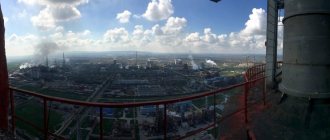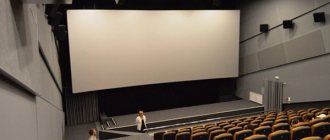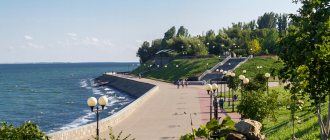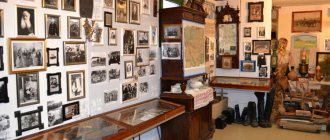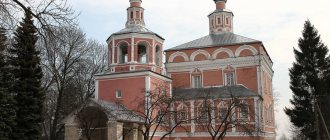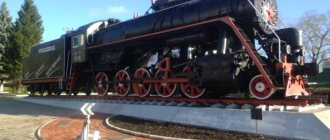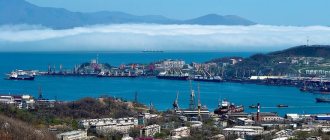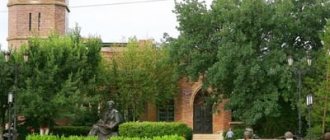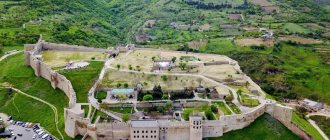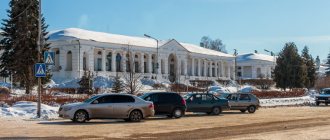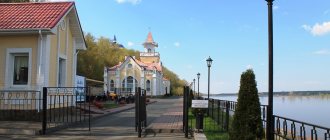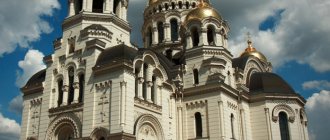Brief historical background
Skopin is an ancient city in the Ryazan region.
It is located on the left bank of the Verda River. Its predecessor, according to archaeologists, was the Slavic Likharevo settlement (XII-XIII centuries, south of Skopin), several villages of the XIV-XVII centuries. found on the right bank of the river. Verdy.
During the formation of the centralized Russian state headed by Moscow, the southern regions of the Ryazan region were the first to repel the raids of nomads.
To protect the southeastern borders, the Moscow state is building a system of defensive fortifications - zaseki, a significant part of which is located on the territory of the Ryazan Territory.
At one of the spots Skopin appeared. It is necessary to clarify that in those days Skopin was called Ostrozhk, i.e. a guard fortified city. In the lists from the Ryazhsk scribe books on the Pekhletsky camp (1595 - 1597) the following description is given: “Behind the boyar, behind Ivan Nikitich Romanov, in the estate of Skopin-fortress on the Verde River.”
Skopin of those years was surrounded by three earthen walls, “the quarter wall from the Verda River is a chopped wooden wall, near the town there are eight wooden towers, the ninth tower is earthen: and that town has only one gate.”
In 1613, the Russian throne was occupied by the elected tsar, boyar Mikhail Fedorovich Romanov, who put a lot of effort into creating a regular, well-trained army. At the beginning of the 17th century, Streletskaya, Pushkarskaya, and Cossack settlements grew in Skopin.
In the second half of the 17th century, Tsar Alexei Mikhailovich issued a charter on the purchase of grain in Ryazan cities. Carts with wheat, rye, oats, buckwheat, millet, pork, chickens and geese, sour cream and other food came from Skopin...
In 1663 Skopin entered the department of the Secret, then the Khlebny, and at the beginning of 1676 - the Streletsky orders. Skopin then became part of the Tsar's Stables Chancellery. With the construction of a new stable yard in 166Z behind Verda, the Skopinskaya stable settlement was formed. In 1708, Tsar Peter I Alekseevich assigned Skopin to the Azov province for ship matters, and in 1719 the city became part of the Yelets province of the Azov province. In 1725, the Azov province was renamed Voronezh.
During these years, the first semi-handicraft workshops for the production of nails and other simple iron and copper products opened in Skopin. Pottery is becoming increasingly famous. Skopinskaya pottery made of baked clay is in great demand at fairs in Moscow, Ryazan, Tula, Nizhny Novgorod, Pskov...
In the 20s of the 18th century, Skopin completely lost its military significance. Now most of the population are merchant families.
In 1731, along with the adjacent villages, it was transferred to the department of the Stable Order. Skopinskaya volost became part of the Dankovsky district of the Yelets province of the Voronezh province. In this regard, all service people are transferred to the category of grooms and peasants of the palace stable office.
On August 24, 1778, with the establishment of the boundaries of the Ryazan governorship by the Palace Stables Chancellery, Skopin was approved as a city and the center of the county. On May 29, 1779, by decree of Empress Catherine II, Skopin received a coat of arms. The coat of arms consists of two parts: in the gold-colored upper part there is a silver sword and scabbard lying crosswise, above them there is a green princely cap; “in the second part of the shield in a blue field there is an osprey bird flying, meaning the name of this city.”
In the middle of the 19th century, in the section on the routes of communication of the Ryazan province, we read that Skopin is located on a busy place - the Transcaucasian or Lipetsk tract, which separated from the Astrakhan highway near the city of Ryazan and went through Pronsk, Skopin, Dankov, Tambov province and beyond.
In 1863, the first city bank opened in Skopin. Its authorized capital is just over 10 thousand rubles. Ivan Gavrilovich Ryvkov, who achieved its opening, becomes the director of the bank.
In the same year, Alexander II signed the law on zemstvo.
Already in the fall of 1868, a member of the Skopin council, Ovchinnikov, reported on the construction of a hospital, on the construction of a large postal road from Skopin to the Korablinskaya station of the Kozlovsko-Ryazan railway through Sistovka, Letovo, Velikaya Luka and Dubovitsy, on the abolition of the large Ryazhsko-Pronskaya road, on the change of owners of the large Dankovskaya road.
In 1868, the first historiographical literature about Skopin appeared - “The Historical, Statistical and Contemporary Significance of the City of Skopin” by I. A. Alekseev.
In the 1870s, the central streets and main squares of Skopin were covered with stone and illuminated by gas lamps, stone houses and warehouses were built, two printing houses were operating, a free library was functioning, almshouses were established, and disabled riff-raff contributed their best to city revenues.
In 1876, a real school was opened. There are plans to open a shelter for infants.
Behind all this lies the activity of the banker I. G. Rykov, who became famous throughout Russia. Each bank has its own charter; The charter of the Skopinsky Bank stated that a third of the income would be spent on the improvement of the city, a third on charity and a third on capital gains. In order to attract customers, the bank announced 6.5 percent deposits, advertising thundered throughout the country, money flowed like a river. Among the depositors were members of the Romanov family, many courtiers, the Ryazan governor... A financial audit in 1882 showed the true state of affairs - bank funds were stolen without a twinge of conscience.
The loudest scandal of the end of the century broke out. Rykov and 25 employees of his bank ended up in the dock. One of the journalists covering the trial was Anton Pavlovich Chekhov.
Nevertheless, thanks to the swindler Rykov, Skopin became one of the best cities in Russia.
In the second half of the 19th century, coal began to be in increasing demand. This gave a powerful impetus to the development of the Skopinsky mines. At the end of the century, the Skopinsky mines became an integral part of the Moscow region coal basin. At the turn of the 19th and 20th centuries, more than 20 mines operated in the county, owned by the Belgian joint-stock company of Mr. Gankar.
The most important event of the 70s of the 19th century in the economic life of the city was the movement of two railways through the county at once: Syzran-Vyazemskaya and Ryazan-Uralskaya. The first connected Skopin with Moscow and the southern provinces, the second - with Tula, Kaluga, Ryazhsk and other large shopping centers of the country.
Trade in grain, livestock, and tobacco is developing more and more. Lace and pottery are increasingly in demand. By the end of the 19th century, in Skopin, with a population of 13 thousand people, there were 4 tanneries, 2 soap factories, 6 oil mills, a starch factory, a bell factory, 2 candle-making factories, a candle-wax factory, an iron foundry, a pottery factory, 2 bone-coal factories, 6 grain mills, and 114 trading establishments. Among the artisans are not only blacksmiths, but also diamond cutters.
The city successfully operates theological and parish schools, a women's gymnasium, a zemstvo hospital, two monasteries, and more than ten churches. In 1895, the city's first museum was opened - the Museum of Russian Weapons.
In 1910, a literary, musical and theatrical circle was created at the noble assembly. Its leader was D. A. Popov, a lover and connoisseur of art. The repertoire of the circle includes works not only by classical writers and composers, but also by their contemporaries. The life of the country in those years was interesting and eventful. The circle of educated people is expanding and their self-awareness is deepening. The life of the radical part of Skopino society is entering a new direction. Revolutionary circles appear in the city. They are headed by S. G. Strumilin, N. P. Kazimirov, A. P. Safonov and others. The names of S. Ya. Elpatievsky and A. V. Fessalonitskaya are being heard more and more often.
At the beginning of December 1917, Soviet power was fully established in Skopin.
The events of those difficult years had a negative impact on the economic life of the city. Local production decreased, crafts died out, several workshops closed, mines failed, and agriculture fell into decay. Hunger began.
With the end of the Civil War, life gradually began to improve: work was resumed and new industrial enterprises opened. The museum of the local region, the Trud theater, new libraries have been opened, and a new newspaper, The Power of Labor, is being published. A society for studying the native land was formed. Cinema, interest clubs, brass bands, drama clubs appeared in the lives of Skopino residents...
In 1925, Skopin became the center of the county, which included 16 volosts.
Vegetable gardening is becoming increasingly widespread in the vicinity of Skopin.
In the 30s of the last century, coal mining became a priority industry. In 1936, coal production amounted to 470 thousand tons. The “Red Handicraftsman” artel, which united potters, is gaining more and more fame. Far beyond Skopin, the names of hereditary masters Ovodov, Tashcheev, Zhelobov, Maksimov, Pelenkin began to sound.
In the early morning of June 22, 1941, German troops crossed the state border of the USSR. The Great Patriotic War began. 26,518 Skopino residents left to defend their homeland. More than 14 thousand people gave their lives for their country.
The city went under martial law. The main enterprise of the region - Skopinsky Mechanical Plant - from the first days of the war was the first to switch to a 12-hour operating mode and manufacture military ammunition and parts for Katyusha rocket launcher shells, two types of aerial bombs and other types of projectiles.
In order to organize military production, the plant was visited by the Minister of Coal Industry V.V. Vakhrushev, his deputy D.G. Onika, and the head of Glavuglemash N.A. Krysavin. They supervised the transfer of machine tools and specialists from many Mosbass mines to the mechanical plant. At the end of October 1941, in connection with the approach of Nazi troops to the city, the evacuation of the mechanical plant to the Urals began to the Egorshinsky Gosmashzavod.
On November 10, 1941, under the Skopinsky Republic of the All-Union Communist Party of Bolsheviks, at the direction of the Ryazan Regional Party Committee, a partisan detachment of 45 people was created. The selection of people was carried out by the first secretary of the RK VKP(b) N.F. Starostin and the head of the district department of the NKVD of the district P.V. Agafonov. The partisan detachment included 5 groups: demolitionists - 5 people, tank destroyers - 7 people, sabotage work - 7 people, scouts - 8 people, messengers - 7 people.
The printing house was also located here - an editorial office of 3 people and a communication group with city organizations and collective farms.
The detachment had three bases in the forest, equipped with dugouts. The detachment's armament consisted of captured German rifles, Molotov cocktails, homemade grenades and one machine gun. The partisan detachment was not destined to conduct full-fledged combat operations, because... The detachment merged with the 84th separate naval rifle brigade of the 1st Shock Army.
On November 27, 1941, Skopin was released.
The liberation of the city marked the beginning of a grandiose offensive by Soviet troops near Moscow.
The Nazis ruled the city for two days, but the damage they caused was great. 26 people were shot, 23 houses were burned, shops, warehouses, and a bank were looted. The mines, distillery, power plant, city water supply, communications, and railway station were destroyed. As soon as the invaders were expelled from the city, restoration of the destroyed began. Electricity and water supply, communications, and radio lines were restored in a short time. The power plant supplied current to the mines, and the machine-building plant produced its first products. The Skopinites supported the front not only with labor, but also with personal savings.
Thirty Skopino residents received the high title of Hero of the Soviet Union, six natives of Skopino land became full holders of the Order of Glory, thousands were awarded military orders and medals.
In the 50s of the last century, the city continued to actively develop. Residential buildings, cultural, social and industrial institutions and enterprises are being built. The city's water supply system is being expanded, the city's electrical network is being reconstructed, and the number of asphalt roads is increasing. The Palace of Culture was built. IN AND. Lenin and kindergarten.
Skopin becomes a major industrial center of the Ryazan region. Along with machine-building, glass, silicate factories, new ones are emerging: hydrometallurgical, construction machinery, electric pumps, etc. Skopin has long been known for its handicrafts - the production of lace, wooden and earthenware. The latter brought the city fame abroad.
Skopin gave the country a whole galaxy of artists, leading scientists, and military leaders. Among them are the composer A.G. Novikov, the author of the famous song “Oh, roads...”, the famous Soviet film director I.V. Lukinsky, who directed the films “Village Detective” and “Chuk and Gek”, playwright A.N. Afinogenov, writer V.I. Palman, Marshal of the Soviet Union and Hero of the Soviet Union S. S. Biryuzov, Hero of the Soviet Union F.A. Poletaev, Hero of the Soviet Union V.P. Komarov.
Monument "Eternal Flame"
In 1995, in honor of the 50th anniversary of the victory in the Great Patriotic War, the Eternal Flame monument was built at the intersection of Lenin and Fadeev streets. The monument is a structure of three flat memorial stones with a sculptural relief on the theme of war. The monument is approached by a small platform on which the eternal flame is located.
Location: Lenin street - 54.
History of the coat of arms
The coat of arms of the municipal formation - the urban district of the city of Skopin was approved by the decision of the Skopin City Council of Deputies dated March 26, 1997 No. 78, entered into the State Heraldic Register of the Russian Federation under No. 166.
Description of the coat of arms: in an azure (blue, blue) field - a silver osprey flying to the right; in the golden free part with a rounded corner is an old green princely hat, trimmed with black fur and facing to the right. The coat of arms is topped with a municipal crown of the established pattern (the heraldic turn to the right indicated in the description corresponds to a turn to the left of the viewer).
The flag of the municipality - the urban district of the city of Skopin was approved by decision of the Skopin City Council of Deputies No. 107/12 of May 23, 1997, entered into the State Heraldic Register No. 167.
Description of the flag: the rectangular flag panel consists of a wide horizontal blue stripe and two narrow yellow (golden) stripes at the top and bottom.
On the blue stripe there is a white image of a flying osprey - the traditional heraldic symbol of the city of Skopin.
The width of the blue stripe is 2/3 of the width of the flag, the width of each of the yellow stripes is 1/6 of the width of the flag.
Temple of St. George the Victorious
In 1754, the Church of St. George the Victorious was built in the city. In 1840, a Sunday school was established at the church. Initially, the church building was wooden and by the middle of the 19th century it completely fell into disrepair. It was decided to jointly build a new church, this time from stone. Construction began in 1860 and lasted two years. In the 1930s, the temple was closed and used as a warehouse. The former Sunday school was converted into a general education school. The temple is currently in need of repairs.
Location: Metallurg village, Pirogov street.
Local authorities
The structure of local government bodies of the Skopinsky urban district is:
— Skopinsky City Council of Deputies is a representative body of local self-government, consisting of deputies elected on the basis of universal, equal and direct suffrage by secret ballot in accordance with federal laws and the laws of the Ryazan region;
- head of the municipal formation - urban district of the city of Skopin (head of the Skopin city district) - the highest official of the municipal formation - urban district of the city of Skopin, elected by the Skopin city Council of Deputies from among its members and acting as chairman of the Skopin city Council of Deputies;
- administration of the municipal formation - urban district of the city of Skopin (administration of the Skopin urban district) - executive and administrative body of the municipal formation - urban district of the city of Skopin, headed by the head of the administration of the Skopin urban district, appointed to a position under a contract;
— control and counting commission of the municipal formation - urban district of the city of Skopin (control and counting commission of the Skopin city district) - control body of the municipal formation - urban district of the city of Skopin. (Article 28 of the Charter of the municipal formation - urban district of the city of Skopin as amended by the decision of the city Council of Deputies dated December 31, 2010 No. 168/62, dated April 28, 2011 No. 52/69).
Monument to the potter
In 2013, a monument to the first Skopinsky potter, Demka Kirieev, was erected on Pushkin Street. It was he who was mentioned in the chronicles of 1640 as the first to introduce pottery in the city. Although it is known that local masters had already thoroughly mastered and applied it by that time. The monument is installed on a high pedestal and represents the figure of a large man holding a clay jug in his hands.
Location: Goncharnaya Square.
Administrative division
Based on the Law of the Ryazan Region dated October 07, 23004 No. 77-03 “On granting the municipality - the city of Skopin the status of an urban district and establishing its boundaries”, the territory of the municipal formation - the urban district of the city of Skopin includes the territory of the city of Skopin with the residential areas of Zarechny and Oktyabrsky, as well as the adjacent lands of the village of Novikovo, the village of Starye Kieltsy, the village of Ivanovka, the village of Krasny Gorodok, the village of Gumenki.
The Law of the Ryazan Region dated August 6, 2008 No. 91-OZ approved the boundaries of the municipal formation - the urban district of Skopin.
Name
There are three versions of the origin of the name. Some historians closely associate the settlement with the Russian princely family of the Skopins-Shuiskys. Others claim that it is based on a legend about a bird of prey of the hawk family called the osprey. Still others are sure that the name is just an old Russian nickname for a thrifty person (from the word save, save).
Local residents also claim that their city was founded by a stingy man who was able to “successfully invest and increase his fortune.” From the thoughts of linguists it follows that the word “skop” is an outdated synonym for the words “warehouse” and “stock”. Wikipedia points to another version of the origin of the name - from the word “skopova” - this is how a person who was elected as a representative of the village at a volost meeting was sometimes called.
Climate, minerals, water resources, soils, forests
The climate is temperate continental with cold snowy winters and warm summers. Precipitation is not evenly distributed throughout the year.
Minerals - brown coal, refractory and refractory clays, gypsum, glass and construction sands, fusible clays, peat.
Water resources are determined by the Verda River, a tributary of the Ranova River. The Verda River within the city has minor tributaries: Kielec, Pesochenka.
The soils are medium deep chernozem.
forests on the territory of the municipal formation - urban district of Skopin .
Factory of Skopin Art Ceramics
Skopin is known for its ceramics and pottery, which can be bought at the local art ceramics factory located on Pushkin Street 93. There are a lot of crafts for every taste. All products are made by hand by the best craftsmen of the city and are conventionally divided into products intended for eating (plates, bowls, spoons, cups, jugs) and decorative ceramics (figurines, figurines).
Location: Pushkin street - 93.
Industry
Based on the results of 2012, the city of Skopin ranks 15th among the municipalities of the region in terms of industrial production volumes. In 2012, 10 industrial enterprises operated in the city, which is 2 more enterprises compared to 2011. A large share in the volume of shipped products of work and services performed is occupied by: production of other non-metallic mineral products - 52.0%, production of machinery and equipment - 40.9%, metallurgical production - 3.6%, textile and clothing production - 2.1 %, publishing and printing activities - 1.4%.
SkopinVtormet LLC implemented an investment project for recycling used car tires. Production started in September of this year. Production capacity is up to 5 thousand tons of crumb rubber per year.
The volume of investments amounted to 19.5 million rubles. The projected payback period is 2 years. The company's plans for 2013 include the production and promotion of safety rubber tiles to the building materials market. This project will create 50 new jobs.
Industrial enterprises:
• JSC "Skopinsky plant GShO"
Address: 391842, Skopin, Ryazan region, microdistrict. Zarechny, st. Zavodskaya, 1.
Tel. (49156)5-20-60, fax (49156)5-20-63.
Year of creation: 1927.
The company produces mine scraper conveyors and spare parts for mining equipment.
• JSC "Skopinskaya Art Ceramics"
Address: 391800, Skopin, Ryazan region, st. Pushkina, 93.
Tel. (49156) 2-11-50, fax (49156) 2-11-66, 2-11-50, 2-22-75.
Year of creation: 1976.
The company produces handicrafts made from ceramics.
• JSC "Skopinsky Souvenir"
Address: 391800, Skopin, Ryazan region, st. Pushkina, 93.
Tel. (49156) 2-11-50, fax (49156) 2-11-66, 2-11-50, 2-22-75.
Year of creation: 2003.
The company produces ceramic products.
• JSC "Skopinsky plant Ital-Decor"
Address: 391800, Skopin, Ryazan region, st. Mira, 1.
Tel./fax (49156) 2-79-66
Year of creation: 2005.
The company carries out decoration and frosting of glass bottles.
• PK Metiz LLC
Address: 391800, Skopin, Ryazan region, st. Pushkina, 97.
Tel./fax (49156) 2-01-48
Year of creation: 1998.
The company produces metal products.
• JSC "Skopinskaya Printing House"
Address: 391800, Skopin, Ryazan region, st. Kr. Square, no. 18.
Tel./fax (49156) 2-04-03
The company carries out printing activities.
• JSC "Skopinskaya Garment Factory"
Address: 391800, Skopin, Ryazan region, st. K. Marksa, 103
Tel./fax (49156) 2-08-24; 0-02-89
Year of creation: 1999.
The company carries out sewing production.
• JSC "Electric pump plant in Skopin"
Address: 391800, Skopin, Ryazan region, Oktyabrsky microdistrict, Sovetskaya st., 10
Tel./fax (49156) 74-1-32
Year of creation: 2002.
The company produces electric pumps for completing metal-cutting machines and other equipment for supplying coolant.
• Skopin Vtormet LLC
Address: 391800, Skopin, Ryazan region, Pushkin street, 152
Tel./fax (49156) 5-04-65
Year of creation: 2012.
The company processes used car tires to produce crumb rubber.
• LLC “Skopinsky Production Association Metallurg”
Address: 391800, Skopin, Ryazan region, Fabrichnaya st., 1
Tel./fax (49156) 5-37-30
Year of creation: 2012.
The company processes concentrates and industrial products of rare refractory metals.
St. Demetrius Monastery
According to one version, the St. Demetrius Monastery appeared thanks to Dmitry Donskoy. Having stopped on Mount Dmitrievskaya to celebrate the victory on the Kulikovo field, he erected this monastery in honor of the Great Martyr Demetrius of Thessalonica. There is also a version that on the site of the monastery there was a wooden chapel in which Alexander Peresvet prayed before the upcoming battle, and left his apple tree staff in it.
With the advent of the revolution, the temple was closed and placed at the disposal of the government. One part of the temple’s shrines was destroyed, and the other was given to museums. In 2010 the monastery was restored and re-opened.
Location: Zarechny village, Dmitrievo village.
Transport
To organize transport services for the population of the city of Skopin, 8 city routes have been organized. The total length of the routes is 133.4 km.
The city of Skopin is connected by rail to the stations of Ryazhsk and Pavelets, so it is possible to create rail passenger connections with Moscow, Tula and Kaluga, Chelyabinsk, and the southern direction.
The road network in the residential part of the city consists of 3 parallel roads from south to north and 5 parallel roads from east to west. Several more narrow roads provide the possibility of vehicle access to any house.
The length of public roads is 88.0 km, including 54.2 km with hard surface, of which 41.5 km with improved surface.
The density of paved roads will be 1.7 km/1000 sq. km.
Communications, media
In the municipality - the city of Skopin, there is an automatic telephone exchange with access to intercity communication.
The municipality has a public Internet access center. Cellular operators operate on the territory of the municipality: Beeline, MTS, Megafon, Skylink, Smarts, Tele2, Corbina Telecom.
The city is almost completely covered by a 3G network, providing access to the Internet outdoors.
In 2002, the municipal unitary enterprise “Teleradio” was created by the municipal unit - the urban district of Skopin, which provides residents with information about the activities of the Skopin urban district. The television company uses a repeater with a power of 1 kW, which allows the signal to cover an area of about 3000 km. (about 100,000 people): Skopin, Skopinsky, Miloslavsky, Pronsky, Korablinsky, Ryazhsky districts.
On the territory of the municipality, the newspaper “Skopinsky Vestnik” is published, which introduces readers to the news of the Skopinsky urban district and region. "Skopinsky Vestnik" is the highest circulation regional newspaper in the region.
Pottery Museum
A branch of the Museum of Local Lore is the Pottery Museum, formed in 2007. To collect exhibits of pottery, the museum organized a festival in which about 150 craftsmen from all over Russia participated. In total, the museum received more than 800 original works, which can still be seen among the exhibits to this day. Now the museum holds such a festival every three years, as a result of which its collection has increased significantly.
Location: Karl Marx street - 95.
Culture, education, social life
The municipality - the urban district of Skopin - is rich in historical and cultural values.
Skopinsk land is the birthplace of Marshal of the Soviet Union S.S. Biryuzov, Hero of the Soviet Union and Hero of Italy F.A. Poletaeva. People's Artist of the USSR, composer A.G. was born here. Novikov, whose name the Skopin Children's Music School proudly bears.
Many places in the city are associated with the names of the illustrator P. Boklevsky and the writer A. Afinogenov. The name of the composer V. Bunin was given to the Skopin Children's Art School. Historical and cultural traditions are actively used today. The city has a local history museum, children's music schools (in the city of Skopin and in the Zarechny microdistrict), an art school in the Avtozavodsky microdistrict, an art and choreographic school, and an art and exhibition salon.
Culture.
Skopinsk land is rich in traditions and talents. There is something to be proud of, something to preserve and develop. Cultural life is multifaceted. In recent years, many major events have been carried out, including those that have already earned recognition, and completely new projects.
One of the main tasks of the city’s cultural institutions is the preservation and development of the rich cultural heritage.
In 2012 cultural workers conducted 685 cultural events.
There are 73 club formations in the city’s cultural institutions, which employ 1,946 people, of which 1,024 are children; 51 amateur folk art groups with 1,189 members. 13 creative groups have the title of “national” amateur group of the Ryazan region and “exemplary”. In 2012, the title “Leading artistic group of the Ryazan region” was awarded to the exemplary ballroom dance ensemble “Alliance”.
The participation of groups in international, all-Russian, regional competitions was awarded: Grand Prix (ensemble "Verditsa"), titles of Laureates - ensembles "Alliance", "Souvenir", "Chance", academic ensemble "Adda", brass band, folk theater.
Schools of additional education, with a total number of students of 775 people, showed good results last year. Students from additional education schools took part in 6 international, 2 all-Russian and 5 regional competitions and festivals of young performers on musical instruments, song creativity, choreographic art, and art exhibitions. Groups, soloists and performers from club institutions and educational institutions in the field of culture took more than 80 prizes.
Schools of additional education for children are engaged in the development and implementation of pre-professional educational programs. Since September 1, 2012, one of the first in the Ryazan region, a children's art school has been operating under the additional pre-professional general education program "Painting", within the framework of which mandatory subject programs have been developed.
For more than 20 years, a local history museum has been continuously operating in the city. It is one of the major cultural centers of our city.
One of the directions of the city’s cultural policy is the development of tourism.
Over the past 2012, with the constant support of the municipal leadership, a lot of work has been done to create conditions for the development of incoming tourism in the city of Skopin.
Specific features - ethnographic relic zone, pottery, proximity to the regional center, the presence of unique natural and man-made landscape areas, historical and cultural potential, good promising opportunities in the field of industrial and agrotourism, as well as a favorable environmental component allow us to talk about the development of incoming tourism in the territory our municipality.
The municipal program “Development of Domestic and Inbound Tourism for 2012 – 2016” has been developed; Clarifications and changes have been made to the “Concept for the development of the pottery museum complex in the city of Skopin, Ryazan region.” Work is underway on thematic and structural plans for each of the halls of the Museum of Pottery. It is planned to expand the exhibition on the first floor of the Museum of Pottery, qualitatively replenish and update museum exhibitions, purchase modern exhibition equipment, and create fundamentally new interactive projects and programs.
The theater “Limit” - (V. Del) and the puppet workshop “Things of the Last Millennium” - (M. Bondareva) have created special tourist programs and master classes. Together with the historical club (teenage club “Rovesnik”), an interactive tourist program “Historical Costume Battle” has been developed. For the same purpose, electronic photo presentations “Temples can never be the same” (Orthodoxy), “In search of the lost” (ethnography), “Merchant town of Skopin” (architecture), two musical advertising photo films: “A swan with a swan is swimming”, “Our row” were created There’s nothing more beautiful!” (folk costume of Skopinsky district) and four versions of thematic booklets with an information insert “The Tale of the Osprey Bird”. Thematic routes in various areas have been developed and tested, the main ones being ethnography, pilgrimage tourism, pottery and tourism tied to a famous name, date and place.
A general list of famous fellow countrymen and people who lived and worked in our area has been compiled. A large amount of photographic material has been collected. To preserve and develop traditional folk arts and crafts of the Ryazan region, the V International Festival of Potters was held from August 14 to 18, 2013. More than 150 people from Russia, the near and far abroad took part in it - artists and masters of ceramic production.
The festival included personal exhibitions, a pottery fair, master classes, seminars and competitions among participants.
Education.
The municipality has 10 municipal preschool educational institutions, 7 general education institutions, including: 1 basic school, 1 basic school, 5 independent general education schools (including 1 open (shift) general education school), 2 branches of basic and basic schools.
During the school year, 18 camps operated on the basis of the city educational institution (including an ecological camp for work and rest at the Station of Young Naturalists, a camp for children and teenagers in difficult life situations “Patriot”).
On the territory of the municipal district of the city of Skopin there are institutions of secondary specialized education: OGBOU SPO "Skopin Technical and Economic College", which for many years has successfully trained accountants, economists, cooks, mechanics, mechanics, welders and other specialists.
There is also a state educational institution “Skopinskaya boarding school” for orphans and children left without parental care.
Famous Skopintsy
Let's name some representatives:
- Anatoly Grigorievich Novikov - People's Artist of the USSR, famous composer, conductor, excellent teacher, Hero of Socialist Labor, was born in Skopin in 1896. He is the author of musical works that everyone has heard: “Dark-skinned Woman,” “Oh, the Roads...”, “March of the Communist Brigades”;
- Sergei Semyonovich Biryuzov is a Soviet military leader, marshal and Hero of the Soviet Union. Born in 1904 in Skopin. He went through the entire war, proving himself several times in battle and command. He was awarded the Orders of Suvorov and Kutuzov, Soviet, Yugoslav and Bulgarian medals. There is a memorial plaque with his name in his hometown.
Please note: more than a dozen streets across the country and abroad are named after Biryuzov.
